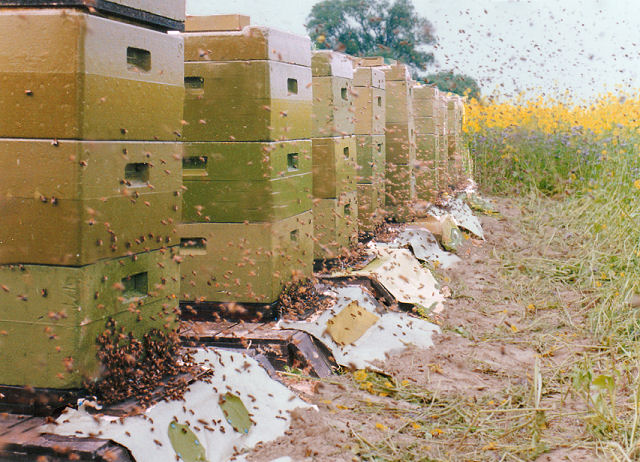 If you are at all privy to the latest beekeeping buzz (a terrible pun I know...and it was intended), you may have heard about a curious phenomenon called Colony Collapse Disease or CCD. Beekeepers in Western countries have been reporting slow declines of stocks for many years, but in early 2007, abnormally high die-offs (30-70% of hives) of European honey bee colonies occurred in the U.S. and Quebec (This is a picture of a hive that experienced CCD). Such a decline has seemed unprecedented in recent history. Apparently when CCD occurs, the bees just mysteriously disappear without a trace; they are no where to be found. Some "experts" have hypothesized that CCD is a result of new agricultural practices and unpredictable weather conditions; however, seasoned beekeepers have posited a different explanation.
If you are at all privy to the latest beekeeping buzz (a terrible pun I know...and it was intended), you may have heard about a curious phenomenon called Colony Collapse Disease or CCD. Beekeepers in Western countries have been reporting slow declines of stocks for many years, but in early 2007, abnormally high die-offs (30-70% of hives) of European honey bee colonies occurred in the U.S. and Quebec (This is a picture of a hive that experienced CCD). Such a decline has seemed unprecedented in recent history. Apparently when CCD occurs, the bees just mysteriously disappear without a trace; they are no where to be found. Some "experts" have hypothesized that CCD is a result of new agricultural practices and unpredictable weather conditions; however, seasoned beekeepers have posited a different explanation.  The problem begins with beekeepers futile efforts to perpetuate the longevity of their hives. All bees are susceptible to mites, this is a problem you can't avoid (In this picture you can see the two mites on the bee). And from what I have learned, almost every beekeeper who has kept a hive for ten years or more has experienced a lost colony. That is, you can't keep the same colony going forever. Despite this fact, ambitious beekeepers have attempted to defy the natural life cycle of the hive by treating their bees with nasty chemicals and pesticides. Though they may think they are winning the battle against varroa mites, they are only further contaminating the colony and the wonderful byproducts of the hive. In particular, those contaminants eventually find their way into the wax comb. This is where the problem really takes off...
The problem begins with beekeepers futile efforts to perpetuate the longevity of their hives. All bees are susceptible to mites, this is a problem you can't avoid (In this picture you can see the two mites on the bee). And from what I have learned, almost every beekeeper who has kept a hive for ten years or more has experienced a lost colony. That is, you can't keep the same colony going forever. Despite this fact, ambitious beekeepers have attempted to defy the natural life cycle of the hive by treating their bees with nasty chemicals and pesticides. Though they may think they are winning the battle against varroa mites, they are only further contaminating the colony and the wonderful byproducts of the hive. In particular, those contaminants eventually find their way into the wax comb. This is where the problem really takes off...Most backyard and commercial beekeepers begin their hive by installing a package of bees into a standard 8 or 10 frame hive. To help the bees get started drawing out comb, the frames in the hive are equipped with a wax foundation imprinted with a hexagonal pattern (As pictured here). In most cases, the bees see the familiar pattern and immediately begin drawing out comb. However, two huge problems. First, this wax foundation is CONTAMINATED. This contamination results in sterile drones which results in failing queens. Second, the hexagonal shape of the foundation is larger than what the bees would create in nature. This leads to unnaturally larger bees, and this leads to bees that are more susceptible to mites. So what can we do to break this vicious cycle? The answer is simple: DON'T spray your bees with chemicals, and DON'T use foundation in your frames. I never thought I would say this, but, LET'S GO ORGANIC! Sweet right? Stay tuned to see how I prepare my foundationless frames.



2 comments:
Derek I swear u will never ceaSe to amaze me. I need to come by and check out the house and the bees! Seriously the way u exlainit makes it interesting stuff...
fascinating. organic honey.
Post a Comment